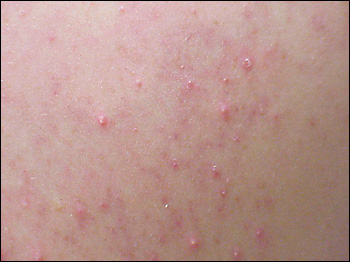
Am Fam Physician. 2005;71(7):1380-1382
A 32-year-old pregnant woman, gravida one, para zero, at an estimated 32 weeks of gestation, complained of several weeks of a progressively worsening, “itchy” rash on her back. She denied having a similar rash before this pregnancy. She felt fine otherwise and had no other complaints.
Physical examination revealed follicular, erythematous papules and pustules scattered evenly across her back and shoulders (see accompanying figure). The central chest was mildly involved. There was no predilection for striae or intertriginous areas, and the abdomen and genitalia were spared. No oral mucosal lesions were noted.

Question
Discussion
The correct answer is B: Pruritic folliculitis of pregnancy. This rare dermatosis occurs in the second and third trimester of pregnancy. It affects an estimated one in 3,000 pregnancies.1 Underreporting is probably common because it may be mistaken for acne or microbial folliculitis.2,3 It is characterized by an acneiform eruption consisting of multiple, pruritic, 2- to 4-mm, follicular papules or pustules typically on the shoulders, upper back, arms, chest, and abdomen. The diagnosis is made clinically after excluding other, more common rashes. The rash usually resolves spontaneously one to two months following delivery.
The exact etiology of pruritic folliculitis is unknown. Small case series have failed to implicate immunologic dysfunction or elevated androgen levels.4–7 On histopathology, an acute sterile folliculitis is evident and direct immunofluorescence stains are negative. The disorder is not associated with maternal or fetal morbidity, although one small series of patients showed a reduction in fetal birth weight.7 Treatment is similar to that of mild acne, consisting of topical benzoyl peroxide. Antihistamines and topical hydrocortisone may be used if severe pruritus exists.
Pruritic urticarial papules and plaques of pregnancy (PUPPP), also known as polymorphic eruption of pregnancy, is the most common dermatosis of pregnancy, occurring in up to one in 160 pregnancies with an increased incidence in multiple gestations.8 It usually occurs in primigravidas in the third trimester and recurrence in subsequent pregnancies is unusual.5 The rash may first appear postpartum. PUPPP typically has a marked pruritic component, the onset of which coincides with the skin lesions. The rash usually begins over the abdomen, commonly involving the striae gravidarum, and may spread to the breasts, upper thighs, and arms. The face, palms, soles, and mucosal surfaces usually are spared. As the name implies, the lesions typically consist of polymorphous, erythematous, nonfollicular papules, plaques, and sometimes vesicles. The lesions can be painful. The rash usually resolves near term or in the early postpartum period.8 Topical emollients and moderately potent steroids in combination with oral antihistamines usually provide some symptomatic relief.
Pruritus gravidarum is a poorly defined condition of pregnancy associated with itching without an obvious dermatosis. The term pruritus gravidarum is classically associated with pruritus in the first trimester. Its etiology and incidence are unknown. The symptoms of pruritus gravidarum usually can be relieved by emollients and antihistamines. It is not clear whether this condition is associated with another more well-defined condition known as intrahepatic cholestasis of pregnancy (ICP),6 but the terms often are used interchangeably in the literature.1 ICP, also called obstetric cholestasis,8 usually presents in the third rather than the first trimester and is the most common liver disorder unique to pregnancy.9 Unrelenting pruritus, abnormal liver function tests in the absence of viral or drug-induced hepatitis, and elevated serum cholic acid are highly suggestive of ICP, with jaundice present in 10 to 15 percent of patients. ICP is associated with poor fetal outcomes including fetal distress, spontaneous preterm delivery, and fetal death and, as such, induction of labor may be warranted.9
Prurigo of pregnancy occurs in approximately one in 300 pregnancies.6 It is characterized by pruritic, often excoriated papules and nodules on the extensor surfaces of the legs and upper arms. The abdomen also may be involved. Onset is variable and has been reported to occur in all trimesters. The etiology and pathogenesis are unknown, although there is sometimes a history of atopy.8 The histopathologic findings of spongiosis, parakeratosis, and marked papillary dermal edema are similar to those occurring in PUPPP. Symptomatic treatment consists of topical steroids, emollients, and oral antihistamines, and resolution typically occurs postpartum.6
Pemphigoid gestationis (formerly herpes gestationis), a rare autoimmune disorder occurring in approximately one in 50,000 pregnancies, begins in the second or third trimester.10 A viral-like prodrome may precede intensely pruritic urticarial lesions on the abdomen. The rash initially may resemble PUPPP, but within a few days, vesicles and tense bullae on erythematous bases usually develop. Periumbilical involvement is characteristic. The condition may resolve late in pregnancy, but classically flares up again at delivery.10 There is an association with prematurity and low birth weight, consistent with mild placental insufficiency.6,8 Treatment does not appear to affect the fetal outcome.6,10 Symptomatic treatment consists of potent topical steroids for mild cases and systemic oral steroids for more severe cases. Affected patients may have nongestational recurrences triggered by oral contraceptives and menstrual cycles.6
| Condition | Characteristics |
|---|---|
| Pruritic urticarial papules and plaques of pregnancy | Papules and plaques often start in stria; occurs in third trimester |
| Pruritic folliculitis of pregnancy | 2- to 4-mm follicular papules and pustules; occurs in second or third trimester |
| Pruritus gravidarum | No rash; occurs in first trimester |
| Prurigo of pregnancy | Papules and nodules on extensor surfaces; occurs in any trimester |
| Pemphigoid gestationis (herpes gestationis) | Vesicles and bullae; occurs in second and third trimesters |